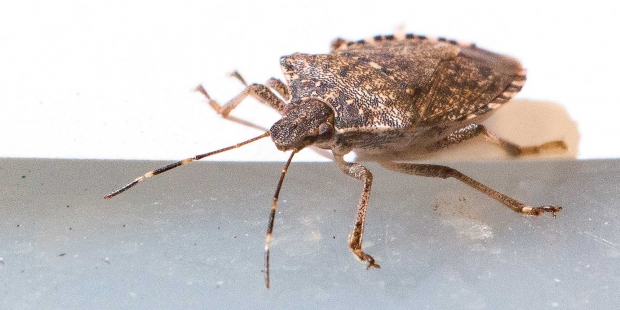
A brown marmorated stink bug (BMSB) (TJ Mullinax/Good Fruit Grower)
Apple growers in the Mid-Atlantic States learned—the hard way—the value of biological control using Integrated Pest Management.
“I have growers who hadn’t sprayed a miticide in 15 or 20 years until brown marmorated stinkbug came around,” said Dr. David Biddinger, tree fruit research entomologist at Pennsylvania State University’s research center in Biglerville.
The arrival of this invasive Asian bug “turned our IPM systems upside down,” he said. Growers resorted to more sprays, applied more times and later in the season, and using harsher pesticides, including pyrethoids for the first time. As a result, outbreaks of secondary pests such as European red mite, San Jose scale, and woolly apple aphid began to occur because they were no longer controlled by beneficial insects, themselves victims of new pesticide regimens.
BMSB has increased growers’ insecticide/miticide bills from about 8 percent of their production costs to 25 percent, Biddinger said, with control of secondary pests adding $100 or more an acre to the cost.
“This pest not only caused a lot of damage for many growers, but extended our spray season right up through harvest time,” he said. “It made us start to look up reentry and preharvest intervals more than we used to, and it brought the first widespread use of pyrethroids to Pennsylvania apple orchards. Pyrethroids were always a bad word in Pennsylvania IPM programs because of the negative effects they have on the biological control of secondary pests such as leafrollers, spider mites, woolly apple aphids, and San Jose scale.”
BMSB also brought the return of harsh, broad-spectrum insecticides like Lannate (methomyl), Thionex (endosulfan), and diazinon. Growers hadn’t used those chemicals much since the days when tufted apple bud moth was the main pest of concern, he said.
These days, Biddinger is on a mission to help growers restore IPM practices to their orchards. He’s written several articles that were published on Penn State’s Fruit Times website, and he speaks frequently at field days and annual horticulture shows, such as the Mid-Atlantic Fruit and Vegetable Convention.
Nature snapping back?
On the good news side, Biddinger sees signs that biological control is exerting itself against the brown marmorated stinkbug. “There was less stinkbug damage this year, and we don’t really know why,” he said. It may be the cold winter last year reduced their numbers. It may be, as he likes to say, “native biocontrol agents are getting used to eating Chinese food.”
That’s a reference to a couple of native species trying to adapt to include the Asian BMSB in their diets. In one study, Biddinger found that 25 percent of BMSB egg masses had been eaten by native predators and the introduced multicolored Asian ladybird beetle.

David Biddinger
Much of the added biocontrol is taking place outside of orchards—a good thing, he said, because brown marmorated stinkbugs spend 90 percent of their lives elsewhere. That makes them hard for fruit growers to control, since they continually invade from woodlots and corn and soybean fields. But it may also mean that biological control agents outside of orchards are already at work.
“Something is happening out there,” he said. “Nature is snapping back.”
As growers learn more about the behavior of the stinkbug and researchers develop better monitoring tools, they react with less panic and more forethought.
“The ability to preserve IPM programs seems to have worked better for large growers with larger blocks and farms where damage to fruit in the border rows was only a small fraction of the total volume of apples harvested,” Biddinger said. “Most of these growers were able to get by with border sprays of the less disruptive neonicotinoid products—Venom and Scorpion (both with the active ingredient dinotefuran)—to control BMSB without developing secondary pest problems.”
“Growers with smaller blocks of fruit and more borders exposed to woodlots or corn and soybean fields could not afford the risk of major crop losses due to BMSB and hit them with everything but the kitchen sink.
“It is our hope that BMSB populations will decline in the near future as some native predator or pathogen decides it likes to eat Asian food as well or that we will be able to import and release Asian Chinese parasitoids that already have a taste for BMSB eggs,” Biddinger said. “Then, hopefully our apple IPM programs will return to normal and we will see fewer secondary pest outbreaks as biological control is re-established.” •






Less damage in the summer of 2014 is far more likely to have been caused by winter kill (95 to 95% in some locations in Virginia). Though some natural predators are now eating the bugs and the eggs of marmorated stink bugs, we have a long ways to go yet for hope of biocontrol. I have done field research on this insect from 2010 through 2014. Pheromone traps are not effective in themselves but when pheromone traps are placed in the center of highly attractive plants, trapping increases by a factor of two to three, though still not effective enough during high infestations.